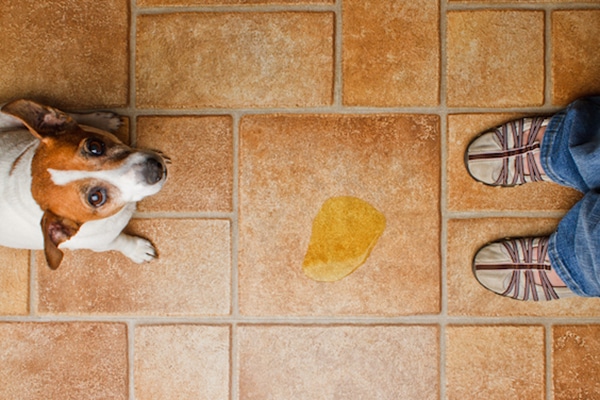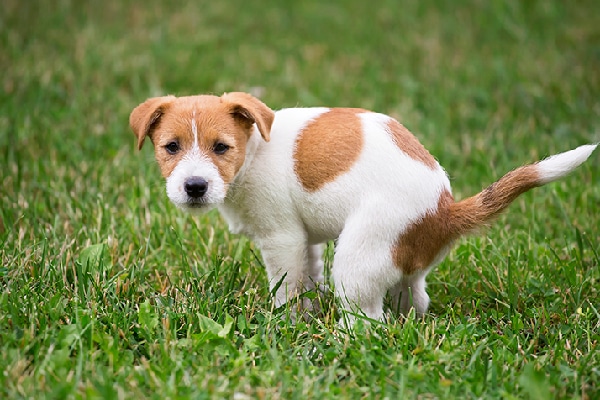House training a dog? I know how it feels. At nine years old, my Yorkie was still not fully housetrained. Rule of thumb when entering the house: Never go barefoot. You never knew where a little wet surprise might be. Smaller breeds may be harder to housetrain, but we were also to blame. With the entire household gone from 8 a.m. to 5 p.m. from the beginning, little Jessy didn’t stand a chance. At one point, we even tried doggie diapers. But she was too slick for that — she easily slithered her way out of them.
If you’re thinking of getting a puppy but aren’t quite sure if you have the patience and time for house training a dog, read on. I sought the help of some experts. No dog should be trained without his owner, but a few helping hands along the way isn’t bad either. Here are some tips when it comes to house training a dog:
1. Get a doggy bell

“For stubborn dogs, you may want to invest in a door bell, such as the Potty Time Chime, as it will provide your dog a tool where he can make it very clear to you that he needs to go out,” says Lina Eklof, Petco’s National Dog Training Lead.
2. Act like mama dog if house training a puppy
“A lot of people get frustrated when their puppies go outside and get distracted and want to play,” says veterinarian Cathy Alinovi. “Usually we have something better to do than to wait for the puppy to go to the bathroom. Be patient, and consider that this is when mama dog would lick the puppy’s bottom to get them to the go to the bathroom.” She recommends wiping the bottom of your dog with a warm wet washcloth to trigger the instinct.
3. Try a deluxe pee pad
Pee pads are a successful route to take for most dogs, but when you’re house training a dog who’s stubborn, she may need a positive reinforcement. Enter the Train ’n Praise Potty Training System. The kit includes two pieces — a replaceable moisture-detection pee pad and a treat dispenser. Whenever the pad detects moisture (when your little guy does No. 1 or No. 2), a wireless signal is sent to the treat dispenser so the dog is always rewarded. Imagine that, house training a dog while you’re at work.
4. Use a litter box when house training a dog
For dog owners who spend much of their time away from home, using a litter box may not sound that crazy. It’s similar to crate training; the dog is allotted a limited space for sleeping, eating and the tray. “It is only through repetition and positive reinforcement that the puppy begins to understand the connection between ‘potty’ and the litter tray,” says Jane Wasley, the Puppy Go Potty brand manager.
“To expedite this connection, it is important to establish a regular dog feeding and watering schedule. By monitoring the feeding and watering, you can quickly become attuned to your puppy’s potty frequency and behavior. This will help you know the most likely times to place the puppy in the tray.”
5. Umbilical cord method
“Many training plans are effective if they are well thought out and consistent,” says veterinarian Kathryn Primm. “I like the ‘umbilical cord’ method where I tie the puppy to my belt loop when I am busy or distracted, so that if she goes sniffing and exploring I can feel the tug. Anytime this was not possible, she stayed in her crate to utilize her natural desire to not soil her den.”
If you encounter a problem similar to that of my full-grown Yorkie, who was still not house trained at nine years old, Primm offers some advice.
“Older dogs with elimination problems should be thoroughly worked up by a vet to rule out medical causes. Nothing damages a human-animal bond like inappropriate elimination. Once the medical causes have been ruled out, the same rebuilding of good habits will work on an older dog. The idea is to maximize their natural tendency to not soil their den and gradually increase the trusted area until the ‘den’ is the whole house.”
Struggling to house train your adult dog? Check out these additional tips >>
Tell us: What are your tips for house training a dog? How did you succeed? Tell us your secrets in the comments!
Thumbnail: Photography © Wavetop | iStock / Getty Images Plus.
This post was originally published in 2014.
About the author
Shannon Farrell is a freelance beauty and fitness writer residing on the Upper East Side of New York City. When she isn’t testing the latest mascara or running through Central Park, she’s dog watching. There isn’t one in Manhattan she hasn’t commented on. #crazydoglady





